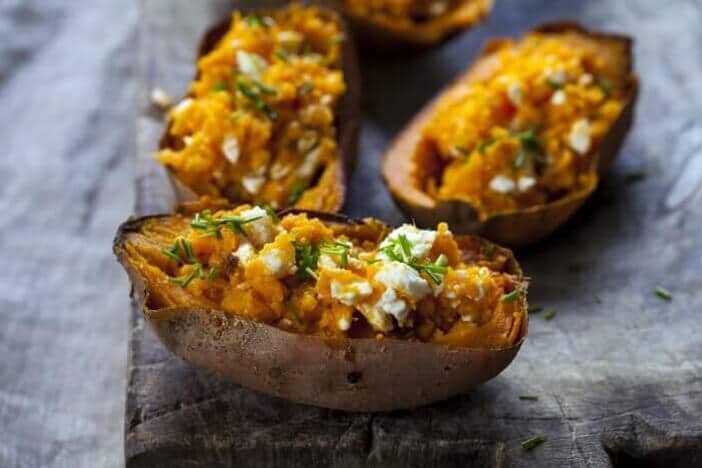Resistant starch - the way to reduce the carbohydrates in your potatoes, pasta and rice

Low carb potatoes? The trick is to boil, cool and then reheat them
Pasta and rice are high in carbohydrates and should be consumed in moderation during a diet. However, we have a trick for how you can reduce the carbohydrate and thus calorie content of pasta and rice dishes and improve your health at the same time. The key phrase here is resistant starch, which is naturally present in many carbohydrate-rich foods. This article explains what it is all about.
Not all carbohydrates are the same
Starch is a polysaccharide which is made up of the two glucose chains amylose and amylopectin. Polysaccharides are long-chain carbohydrates. Cellulose and some fibres also belong to the polysaccharides. Carbohydrates serve primarily for energy supply. How quickly they get into the blood and circulation depends on the number of components in the carbohydrates. This is because the components must first be separated before they can be broken down.
The breakdown of polysaccharides takes the longest time of any carbohydrates. As a result, they remain in the stomach and intestines for longer and are excreted partly unprocessed. This process stimulates digestion, increases stomach volume, can bind to harmful substances and consumes additional energy. For this reason, you should make sure that you get enough dietary fibre even on a low-carb diet.
Which foods contain resistant starch?

The proportion of resistant starch in food depends mainly on the degree of processing. Starch is naturally present in plant-based foods such as potatoes, rice, cereals and legumes, and thus also in products made from it, such as pasta. In the human body, normal starch can be broken down into its components and used to produce energy.
Resistant starch is mainly found in raw carbohydrate-rich foods such as raw potatoes, corn grains, unripe bananas and whole grain bread.
However, we are not suggesting you start eating raw potatoes, raw corn and unripe bananas. There is another way to get food with resistant starch. Resistant starch becomes retrograde starch when foods such as potatoes or grains are cooked and then cooled down again. This starch then becomes indigestible i.e. a dietary fibre.
Upfit tip:
How does this work in practice? It’s actually very simple: you just cook the potatoes (preferably with their skins on), pasta, rice, legumes etc. as normal, then let them cool down completely, preferably in the refrigerator overnight. The next day you can use them to make a salad, fry them or bake them in the oven. Cooling the starchy foods creates crystalline structures that cannot be broken down by your digestive enzymes. By reheating them in a pot, in the oven or in the microwave, the crystalline structure is retained and the starch becomes unusable for your body.
The calorie content of resistant starch is between 1.6 and 2.8 kcal per gram. This is half the calorie content of usable carbohydrates, which average at 4.1 kcal per gram. Not all the starch contained in these carbohydrates can be converted to resistant starch, but the heating and cooling method increases the proportion of resistant starch by up to 10%. This method is well suited to meal prep and pre-cooking, as starchy food can be cooled down completely by storing it in a refrigerator.
An example
200 g boiled potatoes have a calorie value of about 140 kcal and contain 32 % carbohydrates in the form of starch. If you boil the potatoes with their skin on, cool them down completely and then reheat them, they only contain 22 % usable carbohydrates and about 100 kcal. So you have saved 40 kcal.
The carbohydrates are converted into indigestible fibre, which stimulates your digestion and is then excreted again. However if you fry the carbohydrates, be careful not to use too much oil or you will just replace the calories you have saved.
How can you best use resistant starch

Resistant starch is not broken down into energy in the stomach and small intestine, but passes on to the large intestine. In the large intestine it serves as food for the healthy colon bacteria thus promoting them.
Resistant starch influences our insulin levels less than digestible starch. This prevents sudden food cravings and promotes fat loss, because the release of insulin inhibits fat loss.
In addition, a high intake of fibre and resistant starch can prevent diseases such as type 2 diabetes and reduce blood fat and cholesterol levels. It can bind to and help excrete harmful substances in the large intestine and may even prevent colon cancer.
Conclusion
With this method, you will eat satisfying dishes, save calories (use our BMI calculator to calculate your BMI & calorie requirements), increase your fibre intake and do something positive for your bowel health.
Wholegrain bread is also a great source of resistant starch.
Resistant starch is not broken down into energy in the stomach and small intestine, but passes on to the large intestine. In the large intestine it serves as food for the healthy colon bacteria thus promoting them.
Frequently asked questions and answers
Resistant starch is naturally found in raw starch-rich foods such as cereal grains, raw potatoes, raw bananas or raw corn. But it also occurs when you cook starch-rich foods and let them cool down completely (preferably overnight). So if you eat cooked potatoes or pasta from the day before, you will be getting resistant starch.
Resistant starch is not digestible, hence it does not get converted into energy. Resistant starch therefore encourages your body to use up its own energy reserves and break down fat.
Cook (boil, fry or bake) carbohydrate and starchy foods such as pasta, potatoes, rice, corn, cereals and legumes completely and then let them cool down completely. This process turns part of the starch into resistant starch. If you then eat them cold or even warm them up again, the starch will remain in this indigestible state. With an Upfit nutrition plan you get a wide range of dishes that can be precooked and that taste great even when cold!
Sources
- Prof. Dr. oec. troph. Elisabeth Wisker: Resistente Stärke – Ein Ballaststoff kommt in Mode, UGB-Forum 2/01, S. 75-77
- Mike Croghan: Resistente Stärke als funktioneller Bestandteil von Lebensmitteln, Ernährungs-Umschau 50 (2003) Heft 2
- Pschyrembel Klinisches Wörterbuch 2011, 262. Auflage, 2010
- Karl Huth, Marion Burkard: Ballaststoffe, 2004
- UGB-Forum 2/01, S. 75-77


